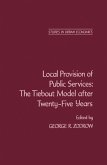Chapter 1 deals with the issue of plant location and siting questions, with a brief overview of water resource modeling, while Chapter 2 provides set-covering models for manpower scheduling as a direct outgrowth of the author's experience with the Sanitation Department in New York City. Chapters 3 and 4 describe the delivery of emergency services, particularly with models of congestion and delay and of optimal deployment. These chapters also present probabilistic analysis in nature since both the spatial and the temporal patterns of demand are intrinsically uncertain. The tools used are queueing theory and geometric probability. Chapter 5 examines network optimization methods, mainly to explore questions of vehicle routing and scheduling. This chapter also provides a few comments on large-scale models of urban growth, these being generally more familiar to the regional planner then to the operations analyst.
This book will prove useful to applied mathematics and policy science students.
Dieser Download kann aus rechtlichen Gründen nur mit Rechnungsadresse in A, B, BG, CY, CZ, D, DK, EW, E, FIN, F, GR, HR, H, IRL, I, LT, L, LR, M, NL, PL, P, R, S, SLO, SK ausgeliefert werden.









